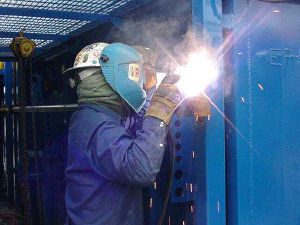Hot Work Safety (Welding, Cutting, and Brazing)

Hot work operations use an open flame or generate sparks, such as cutting, welding, brazing, soldering, grinding, thermal spraying, thawing pipe, and installation of torch-applied roof systems. The majority of indoor campus hot work takes place in EHS approved designated locations. If you are performing hot work in an undesignated location, you must apply for a hot work permit using the Facilities Management Archibus Work Order System.
What you need to know
The University has developed a Hot Work program to comply with the Occupational Safety and Health Administration (OSHA) regulations. The program requires the following:
- Submit a safety service request to determine if a hot work permit is required for your job task
- A hot work permit is not required for the designated indoor hot work locations listed below:
- Smith building room 128 welding area
- Motorsports Kulwicki building room 103 welding area
- Motorsports Research building room 124 welding area
- Rowe building room 114 welding area
- Storrs building room 140 welding area
- EPIC building room 1424 high bay welding area
- Hot work permits must be submitted for indoor hot work in an undesignated location
- Hot work permits must be authorized prior to work starting
- Hot work operators must be designated, authorized, and deemed qualified by their supervisor
- A fire watch must be designated, trained in fire extinguisher use, and remain 30 minutes after hot work operation
- UV shielding should be provided for arc welding
- Personal Protective Equipment (PPE) listed in the equipment owner’s manual must be worn during hot work operation
- The hot work location and equipment must be visually inspected
Services
The Environmental Health and Safety Office offers the following services:
- Consultative regulatory review
- Hot work permit authorization
- Signage
- Limited equipment testing
- Inspections
- Training